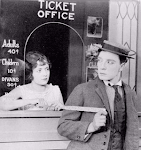
Still lacking for any better ideas, I'm taking another crack at dream pairings for this week's film, Douglas Sirk's
All That Heaven Allows.
First up, we'll have a Sirk double bill with 1956's
There's Always Tomorrow, the film he made after
Heaven. The two films tackle the same basic theme, the agonizing dullness of 1950s middle class life, in fundamentally different ways.
Heaven is shot in glorious Technicolor, focussing on a widow's romance with a younger man (Jane Wyman and Rock Hudson, respectively) and the punishment she receives for this from her children, first by disapproval, then by indifference. Filmed in black and white,
Tomorrow is about a middle class husband (Fred McMurray) who, faced with the indifference of his wife and children, finds himself tempted into an affair with an old colleague (Barbara Stanwyck), resulting in the aggressive disapproval of his children. Both films are therefore about mid-life romances by middle class suburbanites with unpleasant offspring. The different gendered protagonists of the two films combine to show how the 50s pretty much screwed over everyone, men and women, and unites them both in their distaste for their ungrateful children. But while McMurray remains pretty much free to carry on his affair if he chooses, with nothing more than a sly wink from the outside world, Wyman's transgression is a social one, and her entire world tries to shut her down. Also,
There's Always Tomorrow has Rex, the Walking, Talking Robot.

I assume another great pair with
All That Heaven Allows would be with Rainer Werner Fassbender's
Ali: Fear Eats the Soul, about a German widow's romance with an Arab worker. It's Fassbender's homage to
Heaven, but I haven't seen it so I probably shouldn't be recommending it. But I'll take
Chris Fujiwara's word for it: "It’s inaccurate, however, to call Fear Eats the Soul a “remake” of
All That Heaven Allows, as has sometimes been done. There are a few precise echoes of the earlier film in the later one. Emmi’s tearful confession that, despite her pretended indifference, the hatred of the Germans does matter to her, recalls lines spoken by Jane Wyman in the Sirk film; and Fassbinder borrows from Sirk the symbol of a TV set as the sterile link between the heroine and her son (without recreating Sirk’s devastating camera movement toward Wyman’s reflection in the TV screen). But in adapting the story of
All That Heaven Allows. . . Fassbinder simplifies it, makes its contrasts more extreme, turns it away from melodrama and toward fable, and intensifies its motive forces: the love of the couple and the oppression acting on them."

Finally, I'd pair
All That Heaven Allows with Todd Haynes's 2002 film
Far From Heaven, which is like a shinier, dumber remake of the Sirk film: the double feature would show off just how awesome the Sirk really is. I wrote this about it a year ago: "It's a pastiche of Douglas Sirk films, with Julianne Moore and Dennis Haysbert recreating the housewife/gardener dynamic from
All That Heaven Allows. Except in this film, director Todd Haynes adds the twist that the gardener is black, changing the class issues from Sirk's film to racial ones. And, in a twist too far, he gives Moore a husband (Dennis Quaid, trying hard) who's working on trying not to hook up with other men every chance he gets. Haynes just piles on the social issues, and the humanity gets buried behind the topicality. The movie either needed to be a lot longer, giving it a more novelistic scope (at only an hour and forty-five minutes, surely there was room for greater detail on Quaid and Moore in particular), or a lot shorter, focusing on just the Moore/Quaid or Moore/Haysbert relationship. In every other respect, the film is fantastic. The set designs are wonderful, often putting even
Mad Men to shame, but the real star of the film is the lighting: deep reds and blues, gold highlights breaking through the colors, magic hour sunsets and greens for danger, it's all so lovely."















































_1933.jpg)











